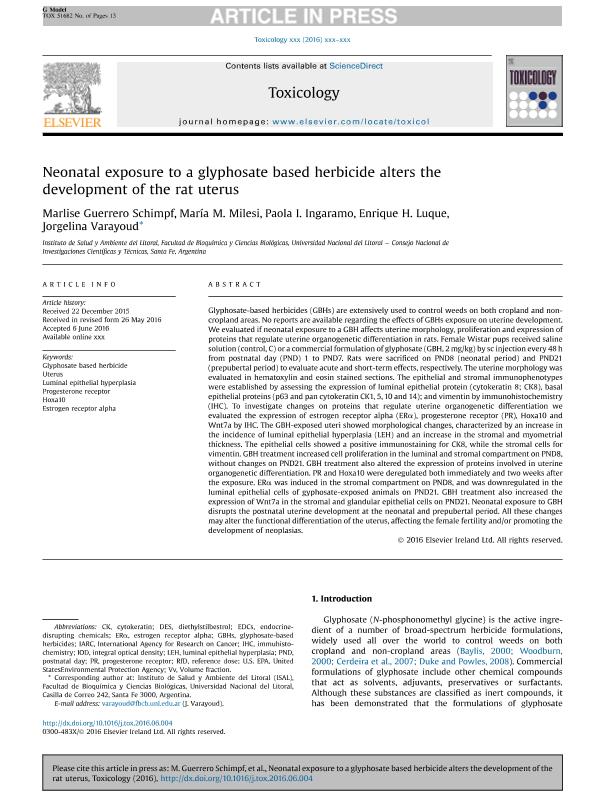Mostrar el registro sencillo del ítem
dc.contributor.author
Guerrero Schimpf, Marlise Luciana

dc.contributor.author
Milesi, Maria Mercedes

dc.contributor.author
Ingaramo, Paola Inés

dc.contributor.author
Luque, Enrique Hugo

dc.contributor.author
Varayoud, Jorgelina Guadalupe

dc.date.available
2018-08-17T15:38:34Z
dc.date.issued
2017-02
dc.identifier.citation
Guerrero Schimpf, Marlise Luciana; Milesi, Maria Mercedes; Ingaramo, Paola Inés; Luque, Enrique Hugo; Varayoud, Jorgelina Guadalupe; Neonatal exposure to a glyphosate based herbicide alters the development of the rat uterus; Elsevier Ireland; Toxicology; 376; 2-2017; 2-14
dc.identifier.issn
0300-483X
dc.identifier.uri
http://hdl.handle.net/11336/56116
dc.description.abstract
Glyphosate-based herbicides (GBHs) are extensively used to control weeds on both cropland and non-cropland areas. No reports are available regarding the effects of GBHs exposure on uterine development. We evaluated if neonatal exposure to a GBH affects uterine morphology, proliferation and expression of proteins that regulate uterine organogenetic differentiation in rats. Female Wistar pups received saline solution (control, C) or a commercial formulation of glyphosate (GBH, 2 mg/kg) by sc injection every 48 h from postnatal day (PND) 1 to PND7. Rats were sacrificed on PND8 (neonatal period) and PND21 (prepubertal period) to evaluate acute and short-term effects, respectively. The uterine morphology was evaluated in hematoxylin and eosin stained sections. The epithelial and stromal immunophenotypes were established by assessing the expression of luminal epithelial protein (cytokeratin 8; CK8), basal epithelial proteins (p63 and pan cytokeratin CK1, 5, 10 and 14); and vimentin by immunohistochemistry (IHC). To investigate changes on proteins that regulate uterine organogenetic differentiation we evaluated the expression of estrogen receptor alpha (ERα), progesterone receptor (PR), Hoxa10 and Wnt7a by IHC. The GBH-exposed uteri showed morphological changes, characterized by an increase in the incidence of luminal epithelial hyperplasia (LEH) and an increase in the stromal and myometrial thickness. The epithelial cells showed a positive immunostaining for CK8, while the stromal cells for vimentin. GBH treatment increased cell proliferation in the luminal and stromal compartment on PND8, without changes on PND21. GBH treatment also altered the expression of proteins involved in uterine organogenetic differentiation. PR and Hoxa10 were deregulated both immediately and two weeks after the exposure. ERα was induced in the stromal compartment on PND8, and was downregulated in the luminal epithelial cells of gyphosate-exposed animals on PND21. GBH treatment also increased the expression of Wnt7a in the stromal and glandular epithelial cells on PND21. Neonatal exposure to GBH disrupts the postnatal uterine development at the neonatal and prepubertal period. All these changes may alter the functional differentiation of the uterus, affecting the female fertility and/or promoting the development of neoplasias.
dc.format
application/pdf
dc.language.iso
eng
dc.publisher
Elsevier Ireland

dc.rights
info:eu-repo/semantics/openAccess
dc.rights.uri
https://creativecommons.org/licenses/by-nc-sa/2.5/ar/
dc.subject
Estrogen Receptor Alpha
dc.subject
Glyphosate Based Herbicide
dc.subject
Hoxa10
dc.subject
Luminal Epithelial Hyperplasia
dc.subject
Progesterone Receptor
dc.subject
Uterus
dc.subject.classification
Otras Ciencias de la Salud

dc.subject.classification
Ciencias de la Salud

dc.subject.classification
CIENCIAS MÉDICAS Y DE LA SALUD

dc.title
Neonatal exposure to a glyphosate based herbicide alters the development of the rat uterus
dc.type
info:eu-repo/semantics/article
dc.type
info:ar-repo/semantics/artículo
dc.type
info:eu-repo/semantics/publishedVersion
dc.date.updated
2018-08-16T17:20:42Z
dc.journal.volume
376
dc.journal.pagination
2-14
dc.journal.pais
Irlanda

dc.journal.ciudad
Limerick
dc.description.fil
Fil: Guerrero Schimpf, Marlise Luciana. Consejo Nacional de Investigaciones Científicas y Técnicas. Centro Científico Tecnológico Conicet - Santa Fe. Instituto de Salud y Ambiente del Litoral. Universidad Nacional del Litoral. Instituto de Salud y Ambiente del Litoral; Argentina
dc.description.fil
Fil: Milesi, Maria Mercedes. Consejo Nacional de Investigaciones Científicas y Técnicas. Centro Científico Tecnológico Conicet - Santa Fe. Instituto de Salud y Ambiente del Litoral. Universidad Nacional del Litoral. Instituto de Salud y Ambiente del Litoral; Argentina
dc.description.fil
Fil: Ingaramo, Paola Inés. Consejo Nacional de Investigaciones Científicas y Técnicas. Centro Científico Tecnológico Conicet - Santa Fe. Instituto de Salud y Ambiente del Litoral. Universidad Nacional del Litoral. Instituto de Salud y Ambiente del Litoral; Argentina
dc.description.fil
Fil: Luque, Enrique Hugo. Consejo Nacional de Investigaciones Científicas y Técnicas. Centro Científico Tecnológico Conicet - Santa Fe. Instituto de Salud y Ambiente del Litoral. Universidad Nacional del Litoral. Instituto de Salud y Ambiente del Litoral; Argentina
dc.description.fil
Fil: Varayoud, Jorgelina Guadalupe. Consejo Nacional de Investigaciones Científicas y Técnicas. Centro Científico Tecnológico Conicet - Santa Fe. Instituto de Salud y Ambiente del Litoral. Universidad Nacional del Litoral. Instituto de Salud y Ambiente del Litoral; Argentina
dc.journal.title
Toxicology

dc.relation.alternativeid
info:eu-repo/semantics/altIdentifier/doi/https://dx.doi.org/10.1016/j.tox.2016.06.004
dc.relation.alternativeid
info:eu-repo/semantics/altIdentifier/url/https://www.sciencedirect.com/science/article/pii/S0300483X16300932
Archivos asociados
